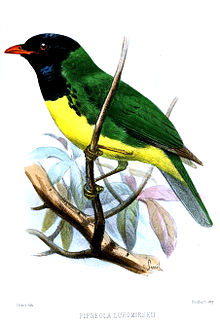
Nombre en español: Frutero Pechinegro
Nombre en inglés: Black-chested Fruiteater
Nombre científico: Pipreola lubomirskii
Familia: Cotingidae
El frutero pechinegro (en Colombia y Ecuador) (Pipreola lubomirskii), también denominado frutero de pecho negro (en Perú) o granicera de pecho negro, es una especie de ave paseriforme de la familia Cotingidae perteneciente al género Pipreola. Es nativa de los Andes del noroeste de América del Sur.
Distribución y hábitat
Se distribuye desde el sur de Colombia (cabecera del Valle del Magdalena y pendiente oriental de los Andes) y en la pendiente oriental en Ecuador y Perú (hacia el sur hasta el norte de Cajamarca, incluyendo la pendiente occidental en el valle de Zaña).
Esta especie es considerada poco común en su hábitat natural, el estrato medio de selvas de montaña entre los 1500 y 2300 m de altitud.
Descripción
Mide en promedio 17 cm de longitud. Pico rojo a anaranjado. El macho presenta la cabeza, garganta y parte superior del pecho, negras; dorso verde; pecho y vientre amarillos. La hebra tiene la cabeza, el dorso, la garganta y la parte superior del pecho, verdes y la parte inferior del vientre con rayas amarillas y verdes. Es frugívoro.

Vocalización

El canto es fino y de timbre alto, por ejemplo un «psiiiiiiít» prolongado y ascendiente, fácil de ser pasado por alto.

Sistemática
Descripción original
La especie P. lubomirskii fue descrita por primera vez por el ornitólogo polaco Władysław Taczanowski en 1879 bajo el mismo nombre científico; la localidad tipo es: «Quebrada de Sance, 1770 m, Tambillo, Perú».

Etimología
El nombre genérico femenino «Pipreola» es un diminutivo del género Pipra, demostrando alguna afinidad entre los mismos y el nombre de la especie «lubomirskii», conmemora al príncipe polaco malacólogo, botánico, colector y patrocinador de expediciones científicas, príncipe Władysław Lubomirski.

Taxonomía
Es pariente próxima con Pipreola jucunda, P. aureopectus y P. pulchra; todas tratadas algunas veces como conespecíficas, pero difieren bastante en el plumaje y no hay indicaciones de intergradación entre ellas. Es monotípica.
Black-chested fruiteater
The black-chested fruiteater (Pipreola lubomirskii) is a species of bird in the family Cotingidae found in Colombia, Ecuador, and Peru, mostly on the eastern side of the Andes. Its natural habitat is subtropical and tropical moist montane forests and the IUCN lists its status as being of «least concern».

Description
Fruiteaters are stocky birds with short tails and short tarsi (lower legs). The black-chested fruiteater is a medium-size fruiteater with a length of 18 cm (7.1 in). The male has a black head, throat and upper breast. The upper parts of the body are bright green and the underparts yellowish-green with mottling on the flanks. The female lacks the black head region and has a bright green back, throat and cheat and underparts streaked with yellow and green. The iris is yellow in both sexes, the beak pinkish-orange and the legs greenish-grey. This species could be confused with the green-and-black fruiteater (Pipreola riefferii), but the latter species has pale barring on the tertial wing feathers, and a yellow border to the black chest in the male. The song is a faint, high-pitched ascending whistle «tseeeeeeweee», and there are further short, rising and falling, whistling calls.
Distribution and habitat
The black-chested fruiteater is native to the Andean region of South America. Its range extends on the eastern side of the Andes from southern Colombia, through Ecuador, to northern Peru; it is found in montane forests and its altitudinal range is 1,500 to 2,300 m (4,900 to 7,500 ft). It also occurs as separate populations locally on the western side of the Andes at Cajamarca and in the south of Marañón Province.
Status
Though somewhat uncommon and with a rather restricted range, the population of the black-chested fruiteater seems stable and the International Union for Conservation of Nature has rated it as being a «least-concern species».

Fuentes: Wikipedia/eBird/xeno-canto


Un comentario en “Frutero Pechinegro/Black-chested Fruiteater/Pipreola lubomirskii”